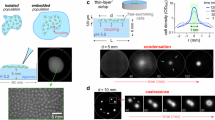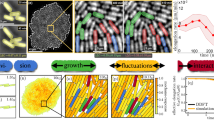Abstract
MOTILE cells of Escherichia coli aggregate to form stable patterns of remarkable regularity when grown from a single point on certain substrates. Central to this self-organization is chemotaxis, the motion of bacteria along gradients of a chemical attractant that the cells themselves excrete1. Here we show how these complex patterns develop. The long-range spatial order arises from interactions between two multicellular aggregate structures: a 'swarm ring' that expands radially, and focal aggregates that have lower mobility. Patterning occurs through alternating domination by these two sources of excreted attractant (which we identify here as aspartate). The pattern geometries vary in a systematic way, depending on how long an aggregate remains active; this depends, in turn, on the initial concentration of substrate (here, succinate).
This is a preview of subscription content, access via your institution
Access options
Subscribe to this journal
Receive 51 print issues and online access
$199.00 per year
only $3.90 per issue
Buy this article
- Purchase on SpringerLink
- Instant access to full article PDF
Prices may be subject to local taxes which are calculated during checkout
Similar content being viewed by others
References
Budrene, E. O. & Berg, H. C. Nature 349, 630–633 (1991).
Woodward, D. E. et al. Biophys. J. 68, 2181–2189 (1995).
Blat, Y. & Eisenbach, M. J. Bact. 177, 1683–1691 (1995).
Neidhardt, F. C., Ingraham, J. L. & Schaechter, M. Physiology of the Bacterial Cell 208 (Sinauer Associates, Sunderland, MA, 1990).
Adler, J. Science 153, 708–716 (1966).
Nossal, R. Expl Cell. Res. 75, 183–142 (1972).
Marcus, M. & Halpern, Y. S. Biochim. biophys. Acta 177, 314–320 (1969).
Gutnick, D., Calvo, J. M., Klopotowski, T. & Ames, B. N. J. Bact. 100, 215–219 (1969).
Adler, J. & Templeton, B. J. gen. Microbiol. 46, 175–184 (1967).
Parkinson, J. S. Genetics 116, 499–500 (1987).
Bruno, W. J. CNLS Newsletter Vol. 82, 1–10 (Centre for Nonlinear Studies, Los Alamos National Lab., Los Alamos, 1992).
Ben-Jacob, E. et al. Nature 373, 566–567 (1995).
Barinaga, M. et al. Science 266, 561–614 (1994).
Wolfe, A. J., Conley, M. P., Kramer, T. J. & Berg, H. C. J. Bact. 169, 1878–1885 (1987).
Miller, J. H. Experiments in Molecular Genetics 431 (Cold Spring Harbor Lab., New York, 1972).
Parkinson, J. S. J. Bact 135, 45–53 (1978).
Author information
Authors and Affiliations
Rights and permissions
About this article
Cite this article
Budrene, E., Berg, H. Dynamics of formation of symmetrical patterns by chemotactic bacteria. Nature 376, 49–53 (1995). https://doi.org/10.1038/376049a0
Received:
Accepted:
Issue Date:
DOI: https://doi.org/10.1038/376049a0
This article is cited by
-
Spatial structure, chemotaxis and quorum sensing shape bacterial biomass accumulation in complex porous media
Nature Communications (2024)
-
Distinguishing Between Long-Transient and Asymptotic States in a Biological Aggregation Model
Bulletin of Mathematical Biology (2024)
-
Microbes in porous environments: from active interactions to emergent feedback
Biophysical Reviews (2024)
-
Spatiotemporal dynamics of the network composed of the memristor Chua’s circuits under external excitation
Nonlinear Dynamics (2024)
-
Non-reciprocity across scales in active mixtures
Nature Communications (2023)



